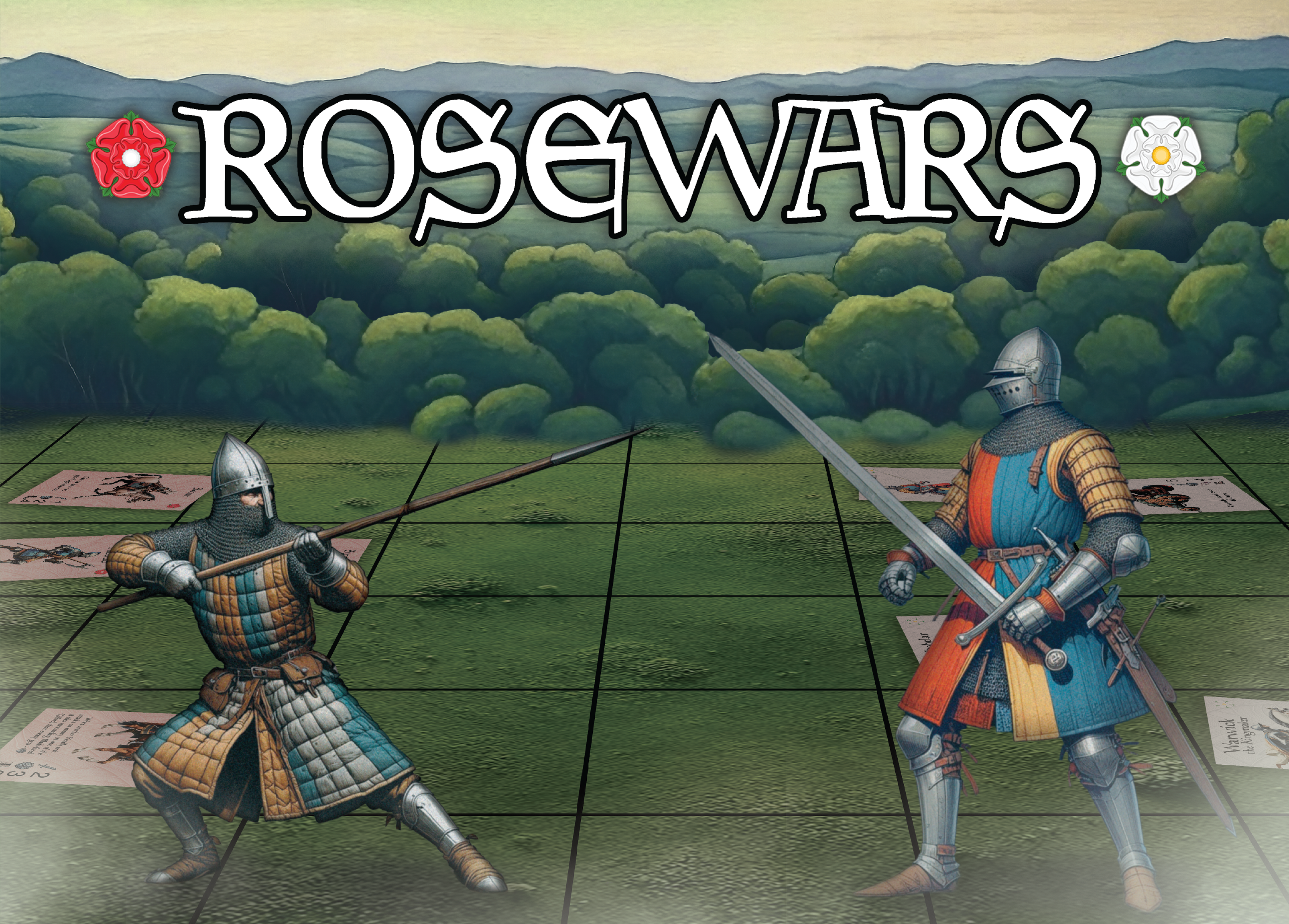Quick, head-to-head warfare in the Wars of the Roses. Outmaneuver your rival on a medieval battlefield.
Rules
Setting
The conflict unfolds during the Wars of the Roses (1455 – 1487). One player commands the House of York (white rose); the other commands the House of Lancaster (red rose).
Objective
Maneuver any one of your units onto your opponent’s back line (the row farthest from you) to capture the head of their house and win.
Components
| Qty | Item | Notes |
|---|---|---|
| 1 | Game board | 8 columns × 6 rows |
| 2 | Six-sided dice | |
| 8 per house | Basic-unit tiles | 2 Longbowmen, 2 Pikemen, 2 Light Cavalry, 2 Knights |
| 10 per house | Special-unit tiles | Marked with the house rose |
| 18 | Action cards | Shared deck |
Setup
- Determine starting player. Each player rolls a die. The higher roll becomes the starting player and chooses which house to command. Both players do the following:
- Gather units. Take the 8 basic units of your house.
- Draw special units. Randomly draw 3 special-unit tiles of your house; return the rest to the box.
- Deploy.
- Secretly split your 11 units into a Front-Line stack and a Rear-Guard stack. Shuffle each stack face-down.
- Place the Front-Line stack face-down on every square of your front line — the row bordering the board’s middle.
- Distribute the Rear-Guard stack face-down on any empty squares of your three back rows.
- Reveal. Flip all units face-up.
- Pikeman adjustment. If, after revealing, both of your Pikemen are entirely in columns 1–2 or columns 7–8, you may move one of them to any empty tile on your half of the board.
- Draw action cards. Shuffle the action-card deck and deal 2 cards to each player.
The game
Turn Structure
Each turn grants two actions. Except the first turn of the game for the starting player grants only one. An action can be used for one of the following:
- Move a unit
- Attack with a unit
- Play an action card that states it requires an action
Unit activation limit: Each individual unit may be chosen for at most one of your actions per turn.
Movement
A unit may move up to its Movement value, one square per point, orthogonally (up, down, left, or right). Diagonal moves are not allowed, and a unit may not move through other units.
except: A unit with Movement 3 could move one square up and two squares right, provided all three squares are clear.
Ranged Attacks
Units that display a range symbol remain on their current square when attacking. They may target any enemy unit within their Range value, counting range exactly as movement is counted. Ranged attacks may shoot over intervening units.
Melee Attacks
All other units are melee units. To attack, a melee unit first moves onto a square orthogonally adjacent to its target, then attacks.
- If the attack defeats the enemy, the attacker may either advance onto the defeated unit’s square or stay where it attacked.
- If the attack fails, the attacker remains on the adjacent square and cannot move again this turn.
Combat Resolution
- The attacker rolls one die. The attack succeeds if the roll is ≤ the unit’s Attack value.
- If the attack succeeds, the defender rolls one die. If the roll is ≤ the unit’s Defense value, the defender survives; otherwise, it is defeated and removed from the board.
Action Cards
Action cards may be played at any time allowed by their text, including playing multiple cards in a single turn.
Battle Bonus
When four of your units have been removed from play, immediately draw one additional action card.
Special Units
Some special units have abilities that override basic rules. Whenever a conflict arises, the text on the special-unit tile takes precedence.
Cavalry vs. Pikemen
Cavalry cannot move past Pikemen. If a Cavalry unit moves forward (toward the opponent’s back line) and ends with a Pikeman directly to its left or right, it may not move farther forward this turn. The Cavalry may still attack a unit farther ahead, but it cannot move onto that square if it wins the battle.
End of Game
Occupy any square on your opponent’s back line to win. Your opponent can win the same way on yours.

